St Winwaloe



.JPG)




.JPG)






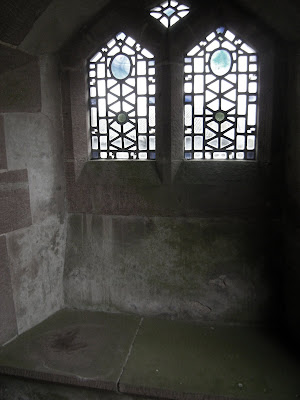














 ________________________________________
________________________________________'It is a mild and pleasant spot, where every year the first flowers open
', and where the leaves are last to fall. A place sheltered from every wind save that from the East, a natural garden, enamelled with flowers of every hue'. So wrote Wurdistan, the biographer of St Winwaloe , about Landevennec in Britanny, Armorica, where Abbot Winwaloe schooled and prepared his Monk for the Mass, for the Mission with which he sent them back to his native land, to which his family had fled following the Saxon invasion.
The Church is dedicated to Saint Wonnow or Winwaloe, an Abbot and Confessor.Possibly monks returned to Wales to evangelise and dediccated various saints in Gwent to them. In the Book of Llandaff, the church is called Ecclesia Llan Gungurarui later Llanwarw. The extinct chapels of Llandevenny near Magor and Llanwynny are said to have been dedicated to him. It is likely therefore, that monks from Llandevenny founded these three churches.Possibly Winwaloe may be the mystery saint of Llandenny
a short version of Llandevenny perhaps?
The Saint's name is given differently as Winwalloe, Gwenaloe, Wingualvens, Winwaloy and Walovay. At the Abbey of Landevennec, Brittany, he is known as Gwenhole.
It would appear he was born in Cornwall, possibly even from this area, of Armorican/Breton and Cornish parents, some time in the mid 5th or 6th century (in Britain it is thought either 457 or 462; at Landevennec it is thought during the 6th Century) and died 532AD approx.
The Family
His father was Fracan, cousin of Cado, Duke of Cornwall, also revered as a Saint as was his mother Gwen ('of the three breasts')They disembarked at Brahestand went up the stream of the Gouet , The 'Bloody River' we don't know the reason for this.Winwaloe had two brothers Gwehenoc and James.-so were clearly alrready Christians.Winwaloe was born after the family had settled there and they sent him to Budoc , who had a school at Lavret to learn the faith and be educated.
A family of Welsh under their leader Rhiwal arrived and they set about building houses around the area now known as Anse d'Iffignac. Winwaloe received reports whilst at Lavret of all the work St Patrick was doing in Ireland and filled with a burning zeeal to do the same. The Christian church was well established in the area of Wales long before this, thanks to the work of missionaries, possibly Joseph of Arimathea, whom the Bards recall was given land at Garth Madrun and then the Missionaries of Pope Eleutherius requested by Llefer Mawr. St Ffagan and St Medwinus (see my post on Michaelston-le Fedw near Newport to find out about this priest and Doctor)but the people were under constant attacks of the Saxons,(Christians were also subject to many persecutions of the Romans) the pagan Irish and even the other Welsh on the Kingdom of Gwent.Winwaloe was granted the wonderful land at Landevennec (Lan is the Breton and Cornish for 'Llan')
Near Winwaloe's home was 'La Meaugan-(Llan Meugan) where priests were trained for the mission in Erin. This was a monastic college of St Mawgan of Cornwall (also a dedication at St Maughan's near Rockfield, Monmouth)BUDOC (after which Bude is named in Cornwall) was trained in Ireland or by Irish monks.There is a legend that Winwaloe had an apparition of St Patrick in a dream who told him to stay where he was and found a monastery and this is what he seems to have done.
LESVEN
In the Chateau at Lesven is a cell of St Winwaloe and there is an altar painting of St Fracan in armour, presenting his son, Winwalloe with the abbey of Landevennec with the 'Three Breasted Gwen above the inscription 'Mamelle d'Or' and S Corentine investing Winwaloe with the Abbey of Landevennec.At the feet of Gwen is De Nobletz a famous Jesuit Missioner to Britain duing the persecution (1577-1654) Also we must not forget it was in Brittany that priests were trained for the Mission at this time-at Douai and at St Omer. Locals say there is another cell to the saint at Ploudalmezau and at Plougain.
The family had been driven out of Cornwall by pagan Saxon invaders and settled in Armorica or Brittany. Young Winwalloe became a disciple of Abbot Budoc and after a short time in Ireland was asked by the Abbot to set up a settlement with eleven monks on the island of Tibidi near Brest. After three years the island was thought to be unsuitable and the monks moved to Landevennec on the River Aulne near Brest. There a semi-fortified monastery was built - the ruins and museum are well worth visiting.
Winwaloe's Character and appearance
His biographer, the monk Wurdistan says of him he was a man of mmoderate height,with a bright and smiling countenance and very patient and gentle in his dealings with men.He always wore a habit off goatskin. He would never sit down in churcch, but always stand, kneel or prostrate himself. He slept on birch bark fibrre and ate girdle cakes baked in ashes,or dumplings with vegetables and a little cheese or fish, but no meat and his drink was cider. During Lent for example, he only ate two good meals a week.
He was so simple minded and pure that he was easily deceived .One of the monks Rioc came to him one day to tell his master that his mmother was dying and he needed to go home. The gentle Winwaloe easily gave permission. When the monk returned after a suitable holiday,Winwaloe asked after her. Rioc put up the story that his mother had died and through prayer he had managed to resussitate her!!! Winwaloe actually believed the story! Rioc had had a good holiday, although you wonder whether he actually confessed this lie to Winwaloe. or perhaps to another of the priests!!! The VITA also tells us of pranks played on the saint by the students dressing up as beasts. At midwinter this was common practice to dress up in costumes so as to frighten the saints.
Winwaloe confront's King Grallos Pagans and meets Gwenael, his discciple and successor, a youth of Welsh Origins,
King Grallo and his court were pagan , but was not hostile, giving Winwaloe grants of land so they could be organised and developed and improve the situation of the people. One day Winwaloe passed some boys at play and one of them ran up to him, knelt at his feet and begged to be admitted into his community.Winwaloe looked into his fresh face, blessed him and went on his way, however he noticed the boy was following him home. He turned and said 'My son, go home. My way is long and arduous and rough' .
'Then I will tread in your footprints' the lad answered and after checking with his parents, who raised no objection, he took Gwenael back to the monastery. The Welsh settlers were called (interesting they were Roman names) Laetitia and Romelius. He was one of the most attached disciples of Winwaloe and remained with him for forty three years, until the death of the Abbot.
The boy Gwenael kneeling before St Winwaloe is recorded in one of the stained glass windows above, and there is also a window showing the saint looking at the Madonna and Child with his disciple Gwenael.
Death of Winwaloe
Winwaloe died on March 3rd on Wednesday of the first week of Lent 532AD after having celebrated Mass and had sung the psalms for Lauds supported on the right and left by two monks.Gwenael became his successor . He is spoken of as being 'full of days'. He gave up eating meat when he was 21. St Thomas Aquinus tells us that the common belief was that meat inflamed the passions.Local tradition says he spent some time at Leon, near Ploudalmezau where there is a cell and a well.It was here that his parents lived.
So here is an approximate chronology of Winwaloe
1. Born upon his mmother's arrival in Brittany............................457AD
2. Sent to BUDOC to be trained as priest at age 10........................467AD
3. 21 years he gives up meat..............................................478AD
4. Leaves Budoc at 23 for Leon............................................480AD
5. Remains at Lesguen for 4 years moves to Tibidy.........................484AD
6. removes and founds Landevennec MMonastery,visits Grallo, consent.......487AD
7. Takes Gwenael as a disciple............................................489AD
8 .Winwaloe dies 'full of days'............................................532AD
Besides Wonastow, there are churches dedicated to St Winwalloe at East Portlemouth and Gunwalloe in the West Country near Heston, probably following the movements of monks from Llandevennec during periods of persecution.
Liber Landevensis, The Book of Llandaff
The first stone church on this site at Wonastow appears to have been built in the 7th century when Cynfwr ap Lago gave the church and village to the Church in Llandaff.
The price he paid for this property was given in old records as:-
a good horse
the value of twelve cows
a hawk
a useful dog worth three cows
a second horse worth three cows
The Norman Church
Wonastow has a twelfth century church dedicated to St. Wonnow or Saint Winwaloe, believed to have been built on a seventh century religious site, possibly even out of Landevennec in Brittany-the Mother House.
Restoration of the CHurch in the 1860's
After the creation of the Anglican Church by Henry VIII, the Norman Church was taken by the Anglicans as well as the Monmouth Priory and a vicar of the new church installed.
The present building was greatly restored in the 1860's. In 1863 the floor was placed over several tombs in the chancel. A plaque giving the names, dating from 1695 to 1804, is on the north wall.
Further restoration was made by Sir John and Lady Searle after they came from Dartmouth to live at Wonastow Court in the 1880's. In 1913 they presented a Rood Screen and an oak reredos.
The steep roof, supported by four pairs of unusual hammer beams, is centuries old. This was restored in 1977 mainly by parochial effort.
The church is basically an early English building of the 12th century with a western tower surmounted by a lantern and pryamadical roof.
The porch was added in the early 1900's, a present by Lady Searle.
The New English Church of Henry VIII
The Church was served by the monks of the Priory Church of Our Lady and St Florent,from the time of the Norman rre-organisation.There may have been a secular priest but more likely was , as is common practice with Benedictine Priories and Abbies, that monks would be sent out to live in the parish for a time and administer the parish on behalf of the monastery. Many of today's monks live out, returning for retreats until their alotted time is over. Again some monks are more suited to parish work than others,The Church,however, passed into Anglican hands and the Catholics had to worship in secret. However, particularly in Monmouthshire, many aristocrats stayed faithful to the Catholic Church and had covert masses said in their private chapels, which could be attended by the faithful. The Use of the Welsh Language was vital in keeping everything secret. There is evidence in Hansard of 1697 that the Milborne family may have been one such family.
The Milborne Family
The Church went with the Manor from the early 16th century and until the early 20th century was in the gift of the Milborne family. (The family tree hangs in the nave.)
John Milborne, High Sherrif, was a supporter of the Parliamentarians during the civil war. Troops were garrisoned at Wonastow Court and their horses stabled in the church.
The Truth is very different. Because of the terrible retribution on any Catholic priest found saying Mass, or any lay person found to be attending, local aristocracy often had Mass secretly said at their own houses and kept priests. The Milbornes were an old Catholic Family and Hilston House was another house in the possession of their family. Henry Milborne was recorder for the town of Monmouth and Hansard from 1679 at the time of the Trial and Examination of Fr David Lewis records Mr Milborne as being engaged in a fight with the Constable of Monmouth, actual fisticuffs as the constable was refusing to quash a recusancy accusation against a discovered faithful Catholic. It seems that the Milbornes also owned the church and property at Llanrothal, where he later died in mysterious circumstances.
The family kept a priest at Histon House and in general, the local Catholics spoke in Welsh and kept together in very good communion, and the inability to speak Welsh at this time made it difficult for authorities to find anything out. In the 18th century, Perthir , also near Monmouth became the centre for the Franciscans and Bishop Matthew Pritchard, the Vicar Apostolic of the West of the UK, who now lies buried under the altar of Rockfield Church.
How the Milbornes supported the parliamentary party during the civil war is a puzzle, but best looked at politically rather than spiritually.Again not all mmembers of families are the same.
The Porch and the figure of the Blessed Virgin, and Our Lady and the Archangel Gabriel
The porch was added in the early 1900's, a present by Lady Searle.
As you enter the porch you will see a statue of the Madonna and Child, and looking up at her, a couple of angels with Rossetti faces. There is a holy water stoup near the main door. The font is embellished with traditional Norman cable moulding. The screen, which is of extreme beauty, is modern. In the windows is some black and yellow glass which is believed to be fragments of old windows.
The church at WONASTOW is well cared for and has some very interesting features, obviously being in the Oxford Movement style of Anglican usage inside-a sacristy for example, the remains of an Easter Sepulchre (which seems to have been adapted for use as a monument to the Milborne Family in Tudor times and seems to have been painted over at one time and other monmuments removed.This adapted sepulchre was the canopied memorial to John and Christiana Milborne, once owners of Wonastow Court.
Although John died in 1637 and their figures have disappeared, their four sons and seven daughters can still be seen at prayer, wearing Stuart costume. There is a side altar and many candles are present. There are photographs in the back of the church, where the vestments seem to indicate the Anglo Catholic usage from the early and mid 19th century.Further evidence for the Anglo Catholic usage can be see at the altar. It is well known, that this part of Monmouthshire retained a covert Catholic identity which never died out.Many parishioners were forced to attend the church sevices of Henry VIII 's new faith on pain of heavy fines and imprisonment and the less wealthy, would attend church but not take communion in order to esccape these punitive fines.
It seems Mary Gunter, of the famous recusant Catholic family at Abergavenny married into this family and likely, that while attending Masses by the Jesuit and Franciscan Missionaries, that the local church to Wonastow Court would have obtained a different aspect and many artefacts, removed by 1580 and others slung out by Olver Cromwell and such iconoclasts,(we hear Cromwell stabled his horses in the church)were replaced.
The Roof
The steep roof, supported by four pairs of unusual hammer beams, is centuries old. This was restored in 1977 mainly by parochial effort.
Relics of St Sebastian , St Hilary and St Agatha brought from Rome 1922 by Father John Lavibond, former Anglo Catholic Priest
The altar, which was given by Lady Adela Searle, and consecrated by Charles, Anglican Bishop of Monmouth, in 1922, has consecration crosses on the slab and symbols of alpha, omega and the chi-ro monogram are in the front panels. It is in this altar that the relics of St Sebastian, St Hilary and St Agatha, which were brought from the city of Rome, were deposited by Fr George Lovibond, a former priest of St Wonnow's.
The Reredos is modern and contains figures of the Virgin Mary, St Dubritius, St Peter and St Joseph. To the left of the altar is the Sacrament House with tabernacle and two adoring angels.
There is a nativity window, where Abbot Winwaloe seems to be present and close to the Holy Family. I will post more about St Winwaloe from Cornwall later this year.















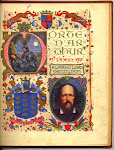







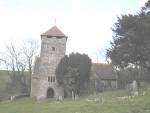
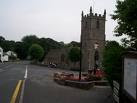


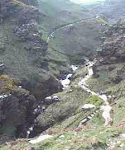




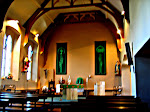









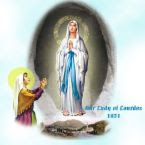


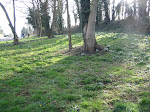

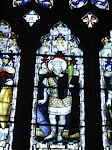
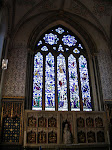
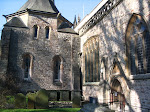
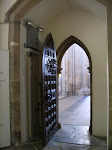
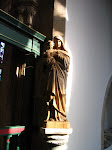


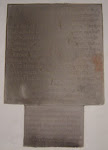



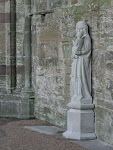









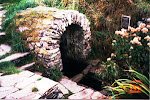


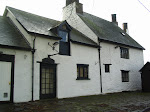
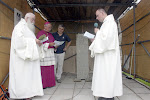



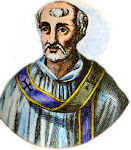
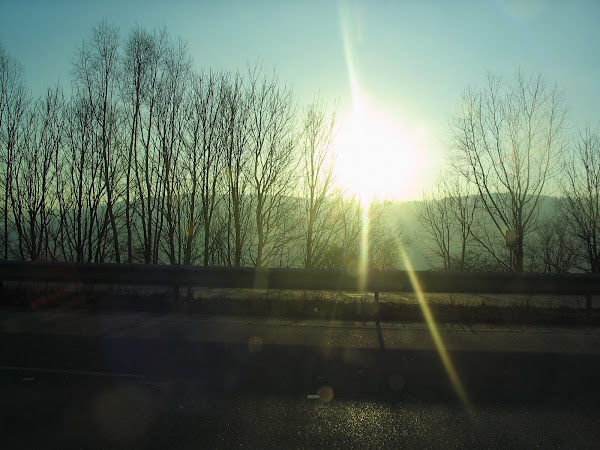


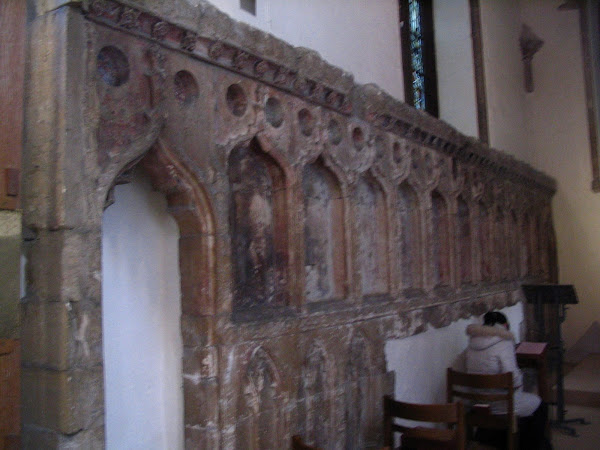
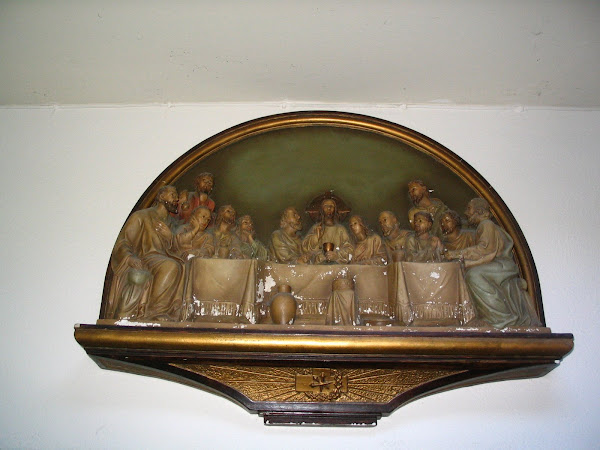




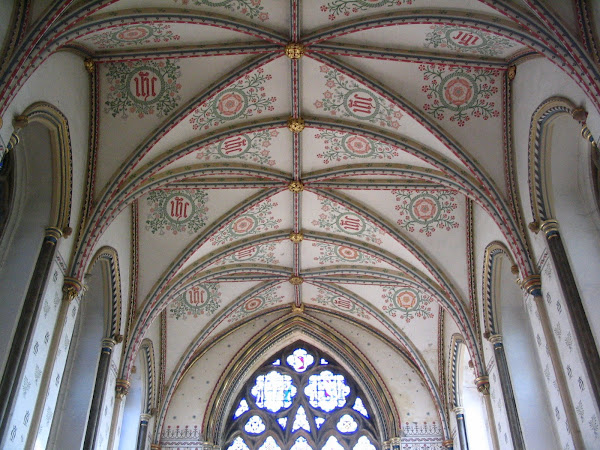


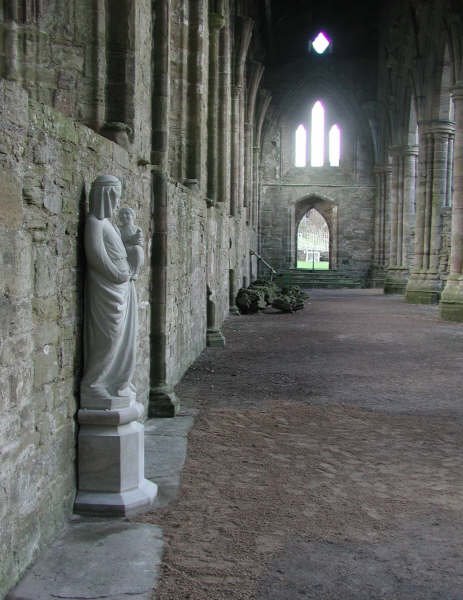
No comments:
Post a Comment